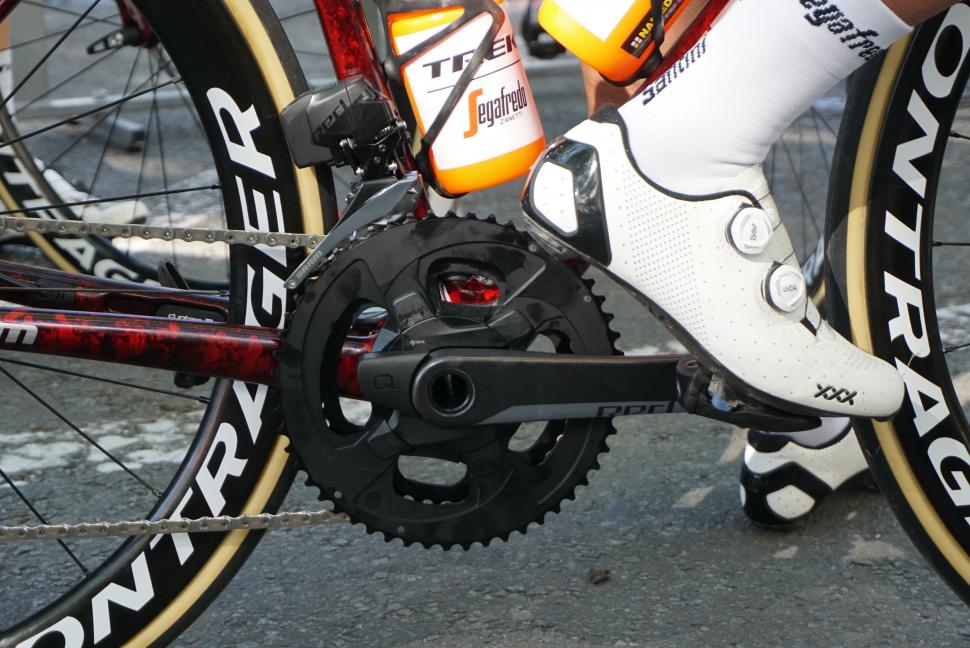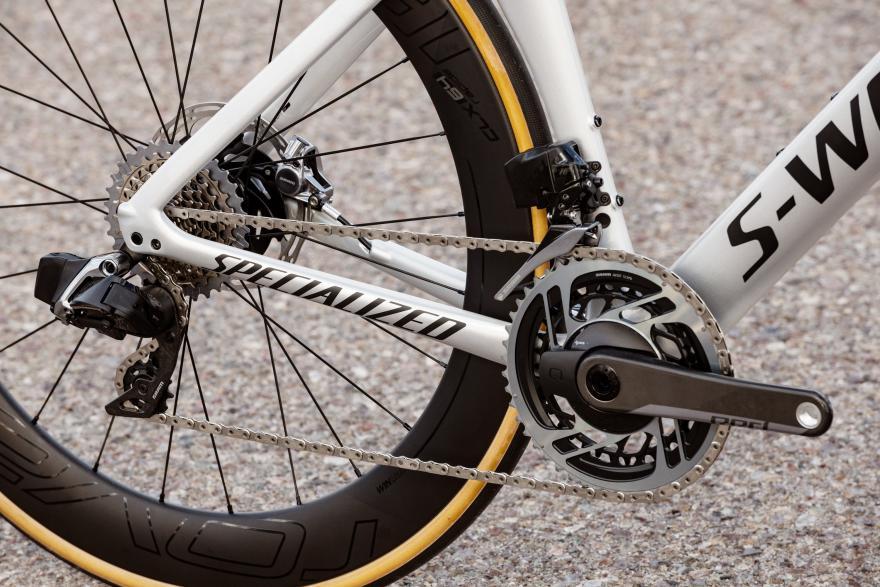- News
- Reviews
- Bikes
- Accessories
- Accessories - misc
- Computer mounts
- Bags
- Bar ends
- Bike bags & cases
- Bottle cages
- Bottles
- Cameras
- Car racks
- Child seats
- Computers
- Glasses
- GPS units
- Helmets
- Lights - front
- Lights - rear
- Lights - sets
- Locks
- Mirrors
- Mudguards
- Racks
- Pumps & CO2 inflators
- Puncture kits
- Reflectives
- Smart watches
- Stands and racks
- Trailers
- Clothing
- Components
- Bar tape & grips
- Bottom brackets
- Brake & gear cables
- Brake & STI levers
- Brake pads & spares
- Brakes
- Cassettes & freewheels
- Chains
- Chainsets & chainrings
- Derailleurs - front
- Derailleurs - rear
- Forks
- Gear levers & shifters
- Groupsets
- Handlebars & extensions
- Headsets
- Hubs
- Inner tubes
- Pedals
- Quick releases & skewers
- Saddles
- Seatposts
- Stems
- Wheels
- Tyres
- Health, fitness and nutrition
- Tools and workshop
- Miscellaneous
- Cross country mountain bikes
- Tubeless valves
- Buyers Guides
- Features
- Forum
- Recommends
- Podcast
TECH NEWS
 Trek Tour bikes1.JPG
Trek Tour bikes1.JPGSpotted: SRAM prototype Red eTap AXS chainsets with regular size chainrings
SRAM sponsors two teams in the 2019 Tour de France peloton - Katusha-Alpecin and Trek-Segafredo - and they’re both using the US company’s newest Red eTap AXS 12-speed disc brake groupset. Only the Trek squad have got some new cranks that we haven’t seen before which suggest the company is trialling some new gear ratios.
The development of the new Red eTap AXS groupset wasn’t really just about adding another sprocket, SRAM introduced a whole new approach to gear ratios. A smaller 10t sprocket on the cassette allowed SRAM to decrease the size of the chainrings, with a 50/37t the biggest it offers as standard.
Let’s give you some numbers for context. That top gear of a 50x10 equates to 131.50 gear inches. For comparison, a conventional 53x11 is 126.76 inches. In other words, SRAM’s new groupset provides a taller top-end than regular groupsets.
But for some reason, a few of the Trek-Segafredo riders, including general classification hopeful Richie Porte, was spotted on a non-standard chainset. There are two things we can observe. The first is that it’s definitely a bigger chainring; we count 53t teeth on the big ring, but some of the teeth are obscured by Porte’s foot.
Why would they want a bigger chainring if the groupset already provides a taller top gear? It could simply be a case of the pros preferring to stick with tried-and-tested equipment and gear ratios - pros are notoriously and perhaps rightly risk-averse when it comes to embracing new tech.
It could be to do with efficiency. The efficiency of a drivetrain is generally understood to be improved with the use of larger sprockets and bigger chainrings because put simply, the chain isn’t rotating as extremely as it does on sprockets with fewer teeth.
But how much difference might it make? SRAM told us it tested the efficiency in its own lab and found the difference to be so small it’s not even worth worrying about. However, the Human Power Technical Journal said: “it was found that larger sprockets provide more efficient transfer of power while smaller sprockets proved to be less efficient.”
- SRAM Red eTap AXS First Ride Review
In the world of professional cycling, even if it’s a difference of 1-2 watts, it could be enough to warrant this deviation from SRAM’s off-the-shelf chainset.
The other observation is that this crankset isn’t a one-piece design like the regular Red crankset, which has the power meter integrated into the chainring. That means you can’t replace one or the other without replacing the whole lot.
We could speculate, and that’s all we can do at this stage, that the team wanted more flexibility and to be able to swap out chainrings, something which the new crankset would offer. There’s still the new Quarq Dzero power meter at the centre, integrated into the crankarm.
SRAM declined to comment, but hopefully, we'll find out more soon.
David worked on the road.cc tech team from 2012-2020. Previously he was editor of Bikemagic.com and before that staff writer at RCUK. He's a seasoned cyclist of all disciplines, from road to mountain biking, touring to cyclo-cross, he only wishes he had time to ride them all. He's mildly competitive, though he'll never admit it, and is a frequent road racer but is too lazy to do really well. He currently resides in the Cotswolds, and you can now find him over on his own YouTube channel David Arthur - Just Ride Bikes.
Latest Comments
- al_bullit 22 min 7 sec ago
Incorrect. The "British Gravel Championships" you refer to were not and indeed still are not, run under BC and are not recognised at a national...
- headingley 23 min 10 sec ago
Cameras (front & rear) are the only way to (try and) sort this kind of behaviour. I've run front and rear camers on my commute for several...
- SimoninSpalding 37 min 11 sec ago
I have Cors N:ext on my summer bike, mainly because they do a 24mm, 25 is REALLY tight on rear brake clearance. I am not impressed with how the...
- Tom_77 1 hour 33 min ago
Typically you will signs like this one.
- chrisonabike 1 hour 39 min ago
However, the highway code revisions now provide more detail and the cyclist overtaking picture has been updated. e.g.:...
- eburtthebike 2 hours 26 min ago
And they were right. It says something about our society that people are prepared to put so much money and effort into opposing something as...
- stonojnr 3 hours 29 min ago
Could make a crass joke about how youre only supposed to flip pancakes today, but i wont...
- Mr Anderson 4 hours 4 min ago
I wouldn't worry too much about the locks being picked, in nearly all cases of bike theft, those Ninja moped gangs, the only things they can pick...


Add new comment
4 comments
Oh no the snake oil’s been exposed
Ceramic Speed did some measurements on chainring size and published a report:
https://www.ceramicspeed.com/media/3502/cross-chaining-and-ring-size-rep...
Page 9 is most relevant. The power loss from using a 39T chainring vs 53T is in the range of about 0.875 W to 1.5 W. Let's use the average of about 1.2 W. The equivalent AXS gearing would be a 48T front chainring, which is somewhere in-between. If we do a linear interpolation (without more data, that's the best we can do), I would estimate that 48T loses about 0.4 W vs the equivalent 53T gearing.
0.4 W out of 250 W (this test's input power) is a 0.16% power difference. I think SRAM's right on this one: the difference is too small to care about. And yet, some teams will probably care anyway.
I'm with Mouton, old chainset and they have probably just started trialling a new power meter that attached with the 8 bolt mount used on the Quarqs
Is it just me or does this look suspiciously like the old 11 speed one, with potentially a new power meter? Just looking at the machining on the rings...
gxp.png